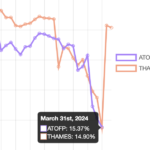Risky Finance has updated its banking visualisation tool for the first quarter of 2020. As the pandemic spread in March, it sent shockwaves through the markets, and signs of this have appeared in bank Pillar 3 filings at the quarter’s end. Below are three insights to be found within our data, on VaR, counterparty risk and securities holdings.
For banks with large trading portfolios, there’s nothing like a bout of market volatility to boost capital requirements. Mathematically, value-at-risk takes volatility and correlation as inputs. When they rise, VaR rises too, and hence market risk weighted assets. The effect is more dramatic still for stress VaR, which applies 2008-level 99thpercentile losses to today’s trading portfolios. For Goldman Sachs, this parameter increased by 50% to a six-year high, boosting market RWAs by a third.
Another effect you might expect to see – but won’t – is the impact of VaR backtest exceptions. When daily trading losses exceed VaR more than statistical models predict, Basel rules require that banks increase the multiplier that converts the VaR into a capital requirement.
For example, HSBC experienced no fewer than 11 VaR exceptions, including a loss of almost $300m on a single day in March on its gold hedging book. BNP Paribas reported 9 VaR exceptions in the quarter, while Wells Fargo experienced 8.
 Levelling the Playing Field
Levelling the Playing Field
 Barclays and Labour's growth plan
Barclays and Labour's growth plan
 Plummeting bonds reflect souring UK mood for outsourcing and privatisation
Plummeting bonds reflect souring UK mood for outsourcing and privatisation
 Dimon rolls trading dice with excess capital
Dimon rolls trading dice with excess capital